初中英语教案(格式规范版)
初中英语教案模板(优秀8篇)
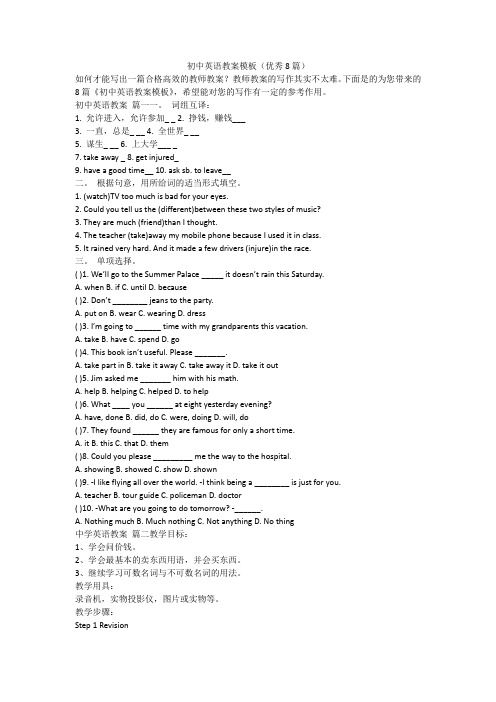
初中英语教案模板(优秀8篇)如何才能写出一篇合格高效的教师教案?教师教案的写作其实不太难。
下面是的为您带来的8篇《初中英语教案模板》,希望能对您的写作有一定的参考作用。
初中英语教案篇一一。
词组互译:1. 允许进入,允许参加_ _2. 挣钱,赚钱___3. 一直,总是_ __4. 全世界_ __5. 谋生_ __6. 上大学___ _7. take away _ 8. get injured_9. have a good time__ 10. ask sb. to leave__二。
根据句意,用所给词的适当形式填空。
1. (watch)TV too much is bad for your eyes.2. Could you tell us the (different)between these two styles of music?3. They are much (friend)than I thought.4. The teacher (take)away my mobile phone because I used it in class.5. It rained very hard. And it made a few drivers (injure)in the race.三。
单项选择。
( )1. We’ll go to the Summer Palace _____ it doesn’t rain this Saturday.A. whenB. ifC. untilD. because( )2. Don’t ________ jeans to the party.A. put onB. wearC. wearingD. dress( )3. I’m going to ______ time with my grandparents this vacation.A. takeB. haveC. spendD. go( )4. This book isn’t useful. Please _______.A. take part inB. take it awayC. take away itD. take it out( )5. Jim asked me _______ him with his math.A. helpB. helpingC. helpedD. to help( )6. What ____ you ______ at eight yesterday evening?A. have, doneB. did, doC. were, doingD. will, do( )7. They found ______ they are famous for only a short time.A. itB. thisC. thatD. them( )8. Could you please _________ me the way to the hospital.A. showingB. showedC. showD. shown( )9. -I like flying all over the world. -I think being a ________ is just for you.A. teacherB. tour guideC. policemanD. doctor( )10. -What are you going to do tomorrow? -______.A. Nothing muchB. Much nothingC. Not anythingD. No thing中学英语教案篇二教学目标:1、学会问价钱。
初中英语教案格式模板范文
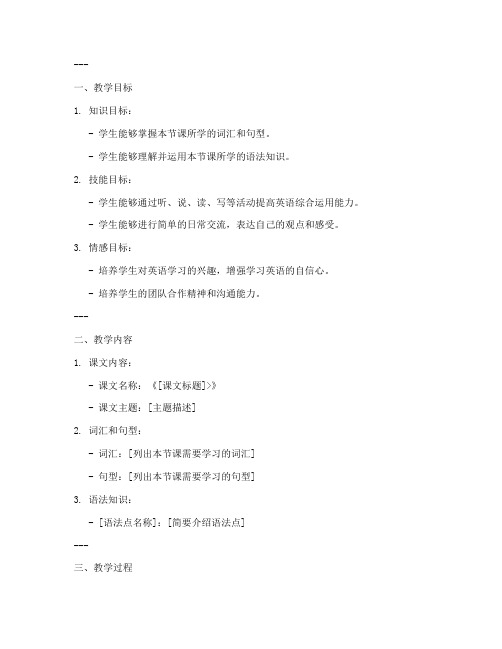
---一、教学目标1. 知识目标:- 学生能够掌握本节课所学的词汇和句型。
- 学生能够理解并运用本节课所学的语法知识。
2. 技能目标:- 学生能够通过听、说、读、写等活动提高英语综合运用能力。
- 学生能够进行简单的日常交流,表达自己的观点和感受。
3. 情感目标:- 培养学生对英语学习的兴趣,增强学习英语的自信心。
- 培养学生的团队合作精神和沟通能力。
---二、教学内容1. 课文内容:- 课文名称:《[课文标题]>》- 课文主题:[主题描述]2. 词汇和句型:- 词汇:[列出本节课需要学习的词汇]- 句型:[列出本节课需要学习的句型]3. 语法知识:- [语法点名称]:[简要介绍语法点]---三、教学过程1. 导入(5分钟)- 活动一:利用图片、视频或歌曲等导入新课,激发学生的学习兴趣。
- 活动二:进行简单的师生互动,复习与新课相关的旧知识。
2. 新课讲解(20分钟)- 活动一:教师讲解课文内容,重点讲解词汇、句型和语法知识。
- 活动二:通过示例句和练习题,帮助学生理解和掌握新知识。
3. 课堂练习(15分钟)- 活动一:进行词汇和句型练习,巩固所学知识。
- 活动二:进行语法练习,提高学生的语法运用能力。
4. 小组活动(15分钟)- 活动一:分组进行角色扮演,模拟课文场景,提高学生的口语表达能力。
- 活动二:小组讨论,分享对课文的理解和感受。
5. 总结与作业布置(5分钟)- 活动一:教师对本节课的内容进行总结,强调重点和难点。
- 活动二:布置课后作业,包括词汇记忆、句型练习和语法练习。
---四、教学评价1. 课堂表现:- 观察学生的参与度、回答问题的准确性等。
2. 作业完成情况:- 检查学生的作业完成情况,了解学生的学习效果。
3. 单元测试:- 通过单元测试,评估学生对本节课内容的掌握程度。
---五、教学反思- 教师对本节课的教学效果进行反思,总结经验教训,为今后的教学提供参考。
---备注:- 本教案仅供参考,教师可根据实际情况进行调整。
完整版初中英语教案模板
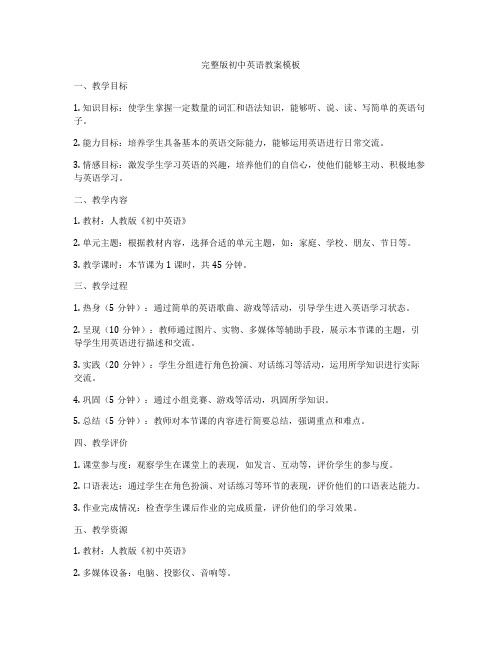
完整版初中英语教案模板一、教学目标1. 知识目标:使学生掌握一定数量的词汇和语法知识,能够听、说、读、写简单的英语句子。
2. 能力目标:培养学生具备基本的英语交际能力,能够运用英语进行日常交流。
3. 情感目标:激发学生学习英语的兴趣,培养他们的自信心,使他们能够主动、积极地参与英语学习。
二、教学内容1. 教材:人教版《初中英语》2. 单元主题:根据教材内容,选择合适的单元主题,如:家庭、学校、朋友、节日等。
3. 教学课时:本节课为1课时,共45分钟。
三、教学过程1. 热身(5分钟):通过简单的英语歌曲、游戏等活动,引导学生进入英语学习状态。
2. 呈现(10分钟):教师通过图片、实物、多媒体等辅助手段,展示本节课的主题,引导学生用英语进行描述和交流。
3. 实践(20分钟):学生分组进行角色扮演、对话练习等活动,运用所学知识进行实际交流。
4. 巩固(5分钟):通过小组竞赛、游戏等活动,巩固所学知识。
5. 总结(5分钟):教师对本节课的内容进行简要总结,强调重点和难点。
四、教学评价1. 课堂参与度:观察学生在课堂上的表现,如发言、互动等,评价学生的参与度。
2. 口语表达:通过学生在角色扮演、对话练习等环节的表现,评价他们的口语表达能力。
3. 作业完成情况:检查学生课后作业的完成质量,评价他们的学习效果。
五、教学资源1. 教材:人教版《初中英语》2. 多媒体设备:电脑、投影仪、音响等。
3. 教具:图片、实物、卡片等。
六、教学建议1. 注重激发学生的学习兴趣,创设生动、活泼的课堂氛围。
2. 鼓励学生主动参与课堂活动,提高他们的口语表达能力。
3. 注重培养学生的团队协作能力,开展小组活动。
4. 教师应注重自身的英语水平,为学生做好榜样。
5. 定期检查学生的作业,及时了解他们的学习情况,给予针对性的指导。
6. 加强与家长的沟通,共同关注学生的英语学习。
综上所述,本节课的教学计划旨在帮助学生掌握一定的英语知识,提高他们的英语交际能力,培养他们学习英语的兴趣。
初中英语教案完整版
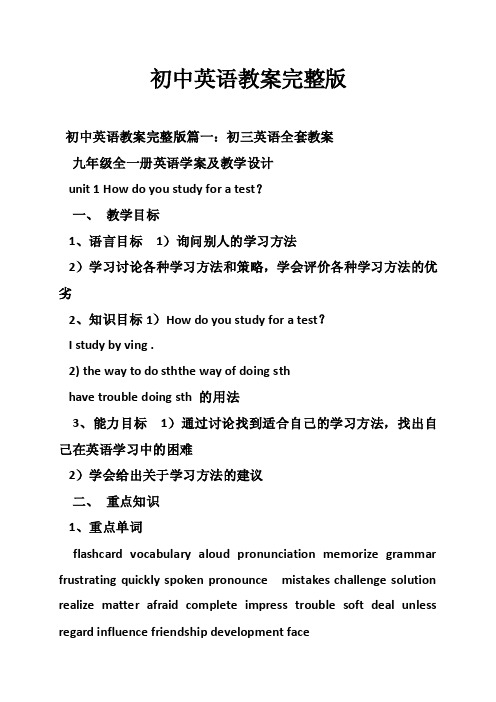
初中英语教案完整版初中英语教案完整版篇一:初三英语全套教案九年级全一册英语学案及教学设计unit 1 How do you study for a test?一、教学目标1、语言目标1)询问别人的学习方法2)学习讨论各种学习方法和策略,学会评价各种学习方法的优劣2、知识目标1)How do you study for a test?I study by ving .2) the way to do sththe way of doing sthhave trouble doing sth 的用法3、能力目标1)通过讨论找到适合自己的学习方法,找出自己在英语学习中的困难2)学会给出关于学习方法的建议二、重点知识1、重点单词flashcard vocabulary aloud pronunciation memorize grammar frustrating quickly spoken pronounce mistakes challenge solution realize matter afraid complete impress trouble soft deal unless regard influence friendship development face基本要求:会读、会写、会用。
2、重点短语make mistakes be afraid to do sth laugh at enjoy doing sth the way to do sth have trouble doing sthend upspoken English practice doing sth too much look upmake vocabulary liststry one`s best to do sth基本要求:会读、会写、会用。
3、重点语法1)How 引起的特殊疑问句及其回答2)the way to do sth the way of doing sthhave trouble doing sth 的用法基本要求:理解其含义,学以致用。
英语教案格式初中
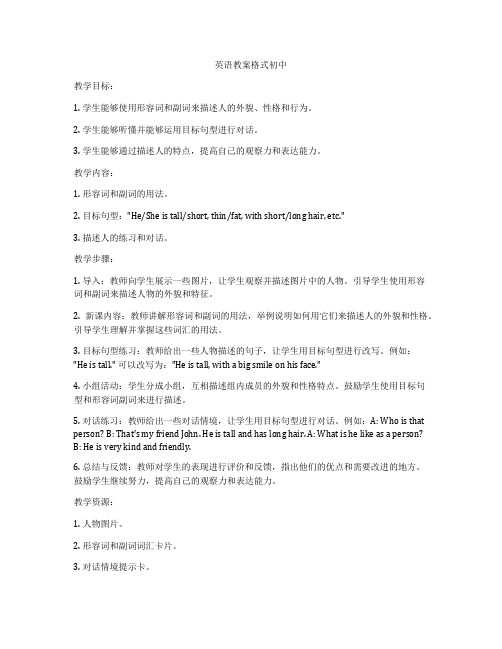
英语教案格式初中教学目标:1. 学生能够使用形容词和副词来描述人的外貌、性格和行为。
2. 学生能够听懂并能够运用目标句型进行对话。
3. 学生能够通过描述人的特点,提高自己的观察力和表达能力。
教学内容:1. 形容词和副词的用法。
2. 目标句型:"He/She is tall/short, thin/fat, with short/long hair, etc."3. 描述人的练习和对话。
教学步骤:1. 导入:教师向学生展示一些图片,让学生观察并描述图片中的人物。
引导学生使用形容词和副词来描述人物的外貌和特征。
2. 新课内容:教师讲解形容词和副词的用法,举例说明如何用它们来描述人的外貌和性格。
引导学生理解并掌握这些词汇的用法。
3. 目标句型练习:教师给出一些人物描述的句子,让学生用目标句型进行改写。
例如:"He is tall." 可以改写为:"He is tall, with a big smile on his face."4. 小组活动:学生分成小组,互相描述组内成员的外貌和性格特点。
鼓励学生使用目标句型和形容词副词来进行描述。
5. 对话练习:教师给出一些对话情境,让学生用目标句型进行对话。
例如:A: Who is that person? B: That's my friend John. He is tall and has long hair. A: What is he like as a person? B: He is very kind and friendly.6. 总结与反馈:教师对学生的表现进行评价和反馈,指出他们的优点和需要改进的地方。
鼓励学生继续努力,提高自己的观察力和表达能力。
教学资源:1. 人物图片。
2. 形容词和副词词汇卡片。
3. 对话情境提示卡。
评估方式:1. 观察学生在小组活动中的描述能力和对话中的运用能力。
初中英语教案教案格式

初中英语教案教案格式教学目标:1. 能够听懂、会说、会读本课的生词和重点句子。
2. 能够通过图片和情景对话,掌握询问时间、地点和表达喜好的句子结构。
3. 能够运用所学知识,进行简单的日常交流。
教学内容:1. 生词:restaurant, hotel, post office, supermarket, bank, hospital, library, gym, next to, between, opposite, on the corner of2. 重点句子:- How do you get to the...?- The... is next to the...- The... is between the... and the...- The... is opposite the...- The... is on the corner of... and...教学步骤:Step 1: 热身(5分钟)1. 老师与学生用中文进行简单的交流,询问学生的日常喜好,如:“你喜欢吃饭还是吃火锅?”、“你喜欢看电影还是打篮球?”等。
2. 学生用中文回答,同时用英语翻译自己的回答。
Step 2: 引入(10分钟)1. 老师出示一张城市地图,引导学生观察地图上的各种地点,如:“餐厅”、“酒店”、“邮局”等。
2. 老师用中文解释地图上的各个地点,同时用英语翻译。
Step 3: 生词学习(15分钟)1. 老师逐一出示生词卡片,引导学生跟读,并用中文解释生词的含义。
2. 学生用英语重复生词,并用中文解释生词的含义。
Step 4: 情景对话(20分钟)1. 老师出示一组图片,每张图片上都有一个地点,如:“餐厅”、“邮局”等。
2. 老师用英语提问:“How do you get to the...?”,学生用英语回答。
3. 学生两人一组,根据图片上的地点,用英语进行情景对话。
Step 5: 小组活动(15分钟)1. 学生分成小组,每组一张城市地图。
初中英语教案(优秀5篇)
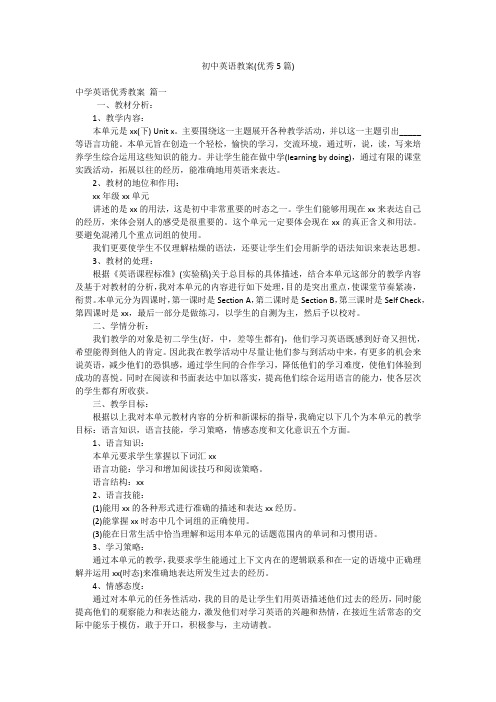
初中英语教案(优秀5篇)中学英语优秀教案篇一一、教材分析:1、教学内容:本单元是xx(下) Unit x。
主要围绕这一主题展开各种教学活动,并以这一主题引出_____等语言功能。
本单元旨在创造一个轻松,愉快的学习,交流环境,通过听,说,读,写来培养学生综合运用这些知识的能力。
并让学生能在做中学(learning by doing),通过有限的课堂实践活动,拓展以往的经历,能准确地用英语来表达。
2、教材的地位和作用:xx年级xx单元讲述的是xx的用法,这是初中非常重要的时态之一。
学生们能够用现在xx来表达自己的经历,来体会别人的感受是很重要的。
这个单元一定要体会现在xx的真正含义和用法。
要避免混淆几个重点词组的使用。
我们更要使学生不仅理解枯燥的语法,还要让学生们会用新学的语法知识来表达思想。
3、教材的处理:根据《英语课程标准》(实验稿)关于总目标的具体描述,结合本单元这部分的教学内容及基于对教材的分析,我对本单元的内容进行如下处理,目的是突出重点,使课堂节奏紧凑,衔贯。
本单元分为四课时,第一课时是Section A,第二课时是Section B,第三课时是Self Check,第四课时是xx,最后一部分是做练习,以学生的自测为主,然后予以校对。
二、学情分析:我们教学的对象是初二学生(好,中,差等生都有),他们学习英语既感到好奇又担忧,希望能得到他人的肯定。
因此我在教学活动中尽量让他们参与到活动中来,有更多的机会来说英语,减少他们的恐惧感,通过学生间的合作学习,降低他们的学习难度,使他们体验到成功的喜悦。
同时在阅读和书面表达中加以落实,提高他们综合运用语言的能力,使各层次的学生都有所收获。
三、教学目标:根据以上我对本单元教材内容的分析和新课标的指导,我确定以下几个为本单元的教学目标:语言知识,语言技能,学习策略,情感态度和文化意识五个方面。
1、语言知识:本单元要求学生掌握以下词汇xx语言功能:学习和增加阅读技巧和阅读策略。
初中英语教案的标准格式5篇
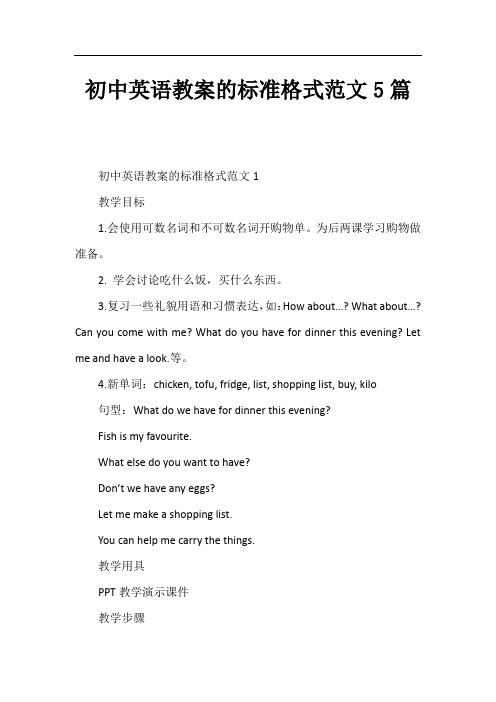
初中英语教案的标准格式范文5篇初中英语教案的标准格式范文1教学目标1.会使用可数名词和不可数名词开购物单。
为后两课学习购物做准备。
2. 学会讨论吃什么饭,买什么东西。
3.复习一些礼貌用语和习惯表达,如:How about…? What about…? Can you come with me? What do you have for dinner this evening? Let me and have a look.等。
4.新单词:chicken, tofu, fridge, list, shopping list, buy, kilo句型:What do we have for dinner this evening?Fish is my favourite.What else do you want to have?Don’t we have any eggs?Let me make a shopping list.You can help me carry the things.教学用具PPT教学演示课件教学步骤Step 1 Revision[课件展示]教师在课堂上提问题,引导学生回答What do you have for breakfast today? Shall we go and buy something to eat? What’s in the pictures? Let me see. What do we have for lunch today? How about…? What about…? What else do you want to have? Can you go and buy the things? Let’s go.等。
老师也可以同样的方式提问全班同学。
教师展示课件中Revision的食物图片,复习一些食品的名称。
Step 2 Presentation[课件展示]教师在复习食品名称基础上,引出购物的话题。
初中英语优秀教案模板范文(汇总12篇)

初中英语优秀教案模板范文(汇总12篇)(经典版)编制人:__________________审核人:__________________审批人:__________________编制单位:__________________编制时间:____年____月____日序言下载提示:该文档是本店铺精心编制而成的,希望大家下载后,能够帮助大家解决实际问题。
文档下载后可定制修改,请根据实际需要进行调整和使用,谢谢!并且,本店铺为大家提供各种类型的经典范文,如工作总结、工作计划、合同协议、条据文书、策划方案、句子大全、作文大全、诗词歌赋、教案资料、其他范文等等,想了解不同范文格式和写法,敬请关注!Download tips: This document is carefully compiled by this editor. I hope that after you download it, it can help you solve practical problems. The document can be customized and modified after downloading, please adjust and use it according to actual needs, thank you!Moreover, our store provides various types of classic sample essays for everyone, such as work summaries, work plans, contract agreements, doctrinal documents, planning plans, complete sentences, complete compositions, poems, songs, teaching materials, and other sample essays. If you want to learn about different sample formats and writing methods, please stay tuned!初中英语优秀教案模板范文(汇总12篇)初中英语优秀教案模板范文第1篇教学目标:1、能听懂、会说、会读、会拼写词汇look for, join, study.2、能听懂、会说、会读日常交际用语和句型Classes are over.Perhaps they are.I’ll go and join them.Where are you going? I’m going to …3、培养学生乐于助人的良好思想品质。
优秀初中英语教学教案5篇
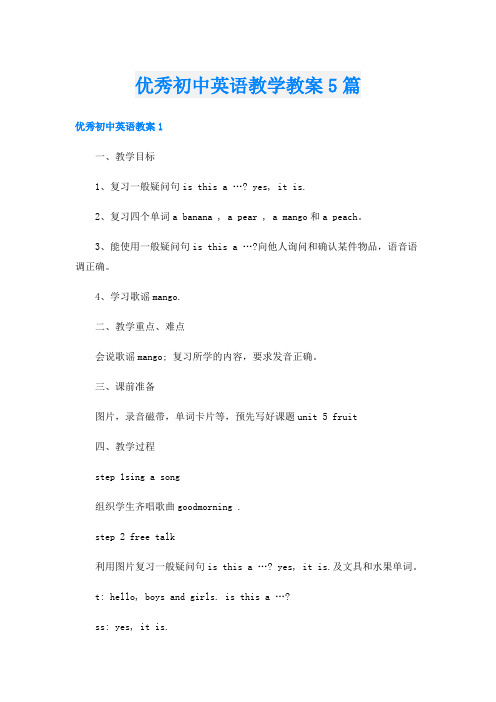
优秀初中英语教学教案5篇优秀初中英语教案1一、教学目标1、复习一般疑问句is this a …? yes, it is.2、复习四个单词a banana , a pear , a mango和a peach。
3、能使用一般疑问句is this a …?向他人询问和确认某件物品,语音语调正确。
4、学习歌谣mango.二、教学重点、难点会说歌谣mango; 复习所学的内容,要求发音正确。
三、课前准备图片,录音磁带,单词卡片等,预先写好课题unit 5 fruit四、教学过程step 1sing a song组织学生齐唱歌曲goodmorning .step 2 free talk利用图片复习一般疑问句is this a …? yes, it is.及文具和水果单词。
t: hello, boys and girls. is this a …?ss: yes, it is.step 3 play a game这是一个“摸摸猜猜”游戏。
教师准备好一个不透明的包,放入需要的物品。
1、讲解游戏的做法。
2、带领全班学生做游戏。
教师先做示范。
t: boys and girls, let’s play a game.t: look! this is my bag. there are many fruit in it, but you can’t see it. you can touch and guess. let me try first.(教师将手伸入包里摸一下水果,想一下,然后闭上眼睛推测is this a ..?一边说一边将水果拿出来给学生看,等到学生给予应答后才睁开眼睛看自己说的对不对。
)优秀初中英语教案2一、教学目标:1. 语言知识目标:1) 能掌握以下单词:allow, wrong, guess, deal, work out能掌握以下句型:①—What’s wrong?—I’m really tried because I studied until midnight last night.② You could give him a ticket to a ball game.③ I think you should ask your parents for some money.④ Why don’t you talk to him about it?2) 能了解以下语法:(1)能够运用所学知识谈论问题和困难、提出建议并做出选择;(2)能根据对方所提出的问题,给出一些合理的建议。
初中英语教案设计模板全英文版
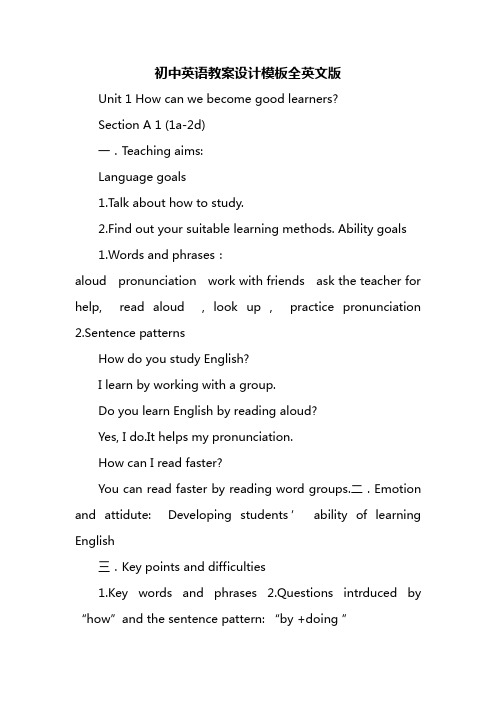
初中英语教案设计模板全英文版Unit 1 How can we become good learners?Section A 1 (1a-2d)一.Teaching aims:Language goals1.Talk about how to study.2.Find out your suitable learning methods. Ability goals1.Words and phrases:aloud pronunciation work with friends ask the teacher for help, read aloud , look up , practice pronunciation 2.Sentence patternsHow do you study English?I learn by working with a group.Do you learn English by reading aloud?Yes, I do.It helps my pronunciation.How can I read faster?You can read faster by reading word groups.二.Emotion and attidute: Developing students’ability of learning English三.Key points and difficulties1.Key words and phrases2.Questions intrduced by “how”and the sentence pattern: “by +doing ”四.Teaching procedures: Step 1 Warming upT: How do you study English? Do you study English by the following ways? (Show some pictures and present the important phrases.)T: How do you study English? S: I study English by ______.by working with friends.by making word cards.by asking the teacher for help.by reading the textbook.by working with a group.by listening tapes.Step 2 1a Check the ways you study English.Then add other ways you sometimes study.___ a.by working with friends.___ b.by making word card.___ c.by reading the textbook.___ d.by listening to tapes ___ e.by asking the teacher for help.…Step 3 Listening1) Listen.How do these students study for a test? Write letters from 1a above.2) Check the answers: b (Meiping); e (Peter); d (Tony) Step 4 Gue Show some pictures.Gue: How does he/she study English? He/She studies English by…How do they study English? They study English by… Step 5 Pairwork1c Make conversations about how you study for a test.A: How do you study for a test?B: I study by working with a group.A: How do you study for a test?B: I study by… Step 6 Listening2a Listen and check the questions you hear.1 ____ Does anyone learn English by watching videos? 2 ____ Do you have conversations with friends in English? 3 ____ What about listening to tapes? 4 ____ What about reading aloud to practice pronunciation? 5 ____ Have you ever studied with a group?Answers: 1, 2, 4, 5 2b Listen again.Match each answer below with a question above.a.Yes, I have.I’ve learned a lot that way.b.Oh, yes.It really improves my speaking skills.c.I do that sometimes.I think it helps.d.No.It’s too hard to understand spoken English.Answers: d, b, c, a Step 7 Pairwork 1.2c Make conversations using the information in 2a and 2bA: Have you ever studied with a group?B: Yes, I have.I’ve learned a lot that way.Show some pictures.1) A: Do you learn English by watching movies?B: Yes, it’s a very interesting way.C: No, it’s too hard to understand spoken English.2) A: What about writing letters to a pen pal in America?B: Yes, it helps to improve my writing skills and know a lot aboutAmerica.3) A: Do you have conversations with friends in English?B: Of course, we can talk about plenty of things like school, pets,movies, and our parents.Step 8 SummaryHow do you study English?1.by working with friends2.by watching English movies.3.by making word cards.4.by reading the textbook.5.by listening to tapes.6.by asking the teacher for help.7.by reading aloud.Step9 Homework How do you study English? What about physics and Chinese? Make a list.Oral Presentation of Leon Plan for Unit 12 My favorite subject is science Go for it Grade 7(注:本说课稿根据“2007年首届全国中学英语教师教学基本功大赛暨教学观摩研讨会(初中)”)[Presenting the 1st PPT about the introduction.] Well,good afternoon ladies and gentlemen, I am very happy to meet you all here.Today,I am going to present Unit 12 Writing.Well, please look at the teaching material together.Well, this is a letter in the book.Students are required to read it through, have a look at it, try to write a letter to Zhao Jie, a boy who doesn’t like any subjects at all.[Presenting the 2nd PPT about the given letter.]Well, I think my teaching aims should include the proper form of English letter, and second, how to write a letter in an idiomatic way.[Presenting the 3rd PPT about the teaching aims.]Well, to achieve these goals, I am going to arrange my teaching step by step [Presenting the 4th PPT about the teaching procedures].Well, these are the steps, since so many, let me make it simple, actually, they are words, sentences and paragraphs.As we know that articles consist of words and sentences.So first, I would like to talk about the words.That is also the first step---revision.Well, you know, students have learned the names of the subjects in the former leons.So, I am going to review the words by playing games with them.Here comes the first game: who can write more? [Presenting the 5th PPT about the 1st game]I am going to divide the students into two groups, for example boys and girls.They are given twominutes to rush to the blackboard and write down the subjects they know.The group which can write more will be the winner.Imagine how excited the students are, and at the same time, they are also reviewing the words.Well, what’s more, you may have noticed these two subjects, Physics and Chemistry.[Presenting the 6th PPT about the result of the game] Actually, these two subjects are not in this book.So, in this way, we can know that some students are showing us how much they know and all the students can also enlarge their vocabulary at the same time.Well, after words, I would like to turn to sentences.Here comes the second game, who can make it longer? [Presenting the 7th PPT about the 2nd game] I am going to give students a word, for example subject.Which students can make it longer? Well, you please.Favorite subject.Good.A phrase appears.Longer? You please.My favorite subject is English.Well, a sentence appears.Even longer? My favorite subject is English, I like it very much, it is so interesting.[Presenting the 8th PPT about the answers of the game]Well, you can see students are constructing words into sentences step by step.Well, this is the revision part.After that, it is time to read.From now, I am going to show students the given material so soon.Actually, instead, I am going toshow them those separated pieces.They should put them into the correct order[Presenting the 9th PPT about the reordering task].You know before the leon, I divided the whole letter into these four parts, why do I bother to do this? Well, you can see, in this way, students can put more attention to how to begin and how to end a letter.Then, they have a time, can have a chance to read through the whole article[Presenting the 10 th PPT about the reading material].Well, at the same time, they should also pick out those well used words and sentences, and share them with the whole cla.Then, they have a discuion “what information can we use? [Presenting the 11th PPT about the discuion task]Why talking about subjects? Of course, it is easy for them to find these information like these three ones ( time Additional material(The new Star Wars movie, Be Careful with Numbers) Teaching Objectives: Knowledge objectives: To enable students to listen and complete some exercises Ability Objectives: To encourage the students to have basic skills of listening.Emotion objectives: To cultivate the cooperation through peer interaction Teaching aids: Multi-media Teaching and learning method: Guiding for learning Teaching Procedures: I.Presentation Today we¡¯ll ha ve a cla on listening practice ¡°Be careful with numbers inlistening¡±: First we¡¯ll play a game.Then, we¡¯ll practice.Lead-in A game on number II.Performance: Quick and accurate response to numbers is very important in daily communication.Telephone numbers, addrees, prices, temperatures, time and dates all closely linked with the use of numbers .Besides, numbers also play a very important part in broadcast programmes such as reports Now let¡¯s listen to some advice from experts.Task 1 Be Careful with Numbers (Play the recorder Twice) Individual work¡úpair work(check the answer with your partner)¡úGroup work(Underline the important sentences.e.g.The differences between million and billion, ¡°-teen¡¯s¡± and ¡°-ty¡¯s¡± are ¡-..¡°Seventeen point five million.¡±¡-)Whole cla read the key sentences. Well-done! Numbers are all around us.Let us practice with numbers and learn to be good at numbers.(First read out the following numbers¡- Watch the screen) T ask 2 Listen to some statements about the brief history of films and TV.First check the answers in groups.If you have different opinion , please raise your hands.Judgement: (First students give themselves a judge.Then teacher does it) It seems no challenge.Now, We¡¯ll do challenge exercise.So pay special attention to the numbers in the paage and select the correct answer from the choiceslisted below.First teach the students new words in listening material.Then ask students to read out the numbers in Star Wars.III.Promotion: Challenge exercise Star Wars Listen to the tape twice ¡úCheck the answers IV.Conclusion: What we learned today is ¡°Be careful with numbers in numbers.¡± Remember the following points when you are doing listening tasks: 1.Take great care with the spelling of names and with addrees and phones numbers, prices, time and dates...2.To find the right answer, you may need to do simple calculations or combine two sets of data.3.Listen carefully for words and phrases such as these: half / twice as expensive as¡- it¡¯s shorter / cheaper / quicker than¡- the lightest / heaviest / newest not as long / cheap / good as¡- Some useful abbreviations and symbols for note taking( See PPt.) V.Aignment: 1.Review P6-7 ¨CFilling in forms P43¨C Working with numbers 2.Collect some information on listening skills Teaching Plan Be Careful with Numbers in Listening Cla: Cla 12, Senior Two Date: May 16,2007 Teacher: Ni Yazhen School: Zhi Yuan Senior High School Teaching Material: P75 S2B Oxford English; Additional material(The new Star Wars movie, Be Careful with Numbers) Teaching Objectives: Knowledge objectives: To enable students to listen andcomplete some exercises Ability Objectives: To encourage the students to have basic skills of listening.Emotion objectives: To cultivate the cooperation through peer interaction Teaching aids: Multi-media Teaching and learning method: Guiding for learning Teaching Procedures: I.Presentation Today we¡¯ll have a cla on listening practice ¡°Be careful with numbers in listening¡±: First we¡¯ll play a game.Then, we¡¯ll practice.Lead-in A game on number II.Performance: Quick and accurate response to numbers is very important in daily communication.Telephone numbers, addrees, prices, temperatures, time and dates all closely linked with the use of numbers .Besides, numbers also play a very important part in broadcast programmes such as reports Now let¡¯s listen to some advice from experts.Task 1 Be Careful with Numbers (Play the recorder Twice) Individual work¡úpair work(check the answer with your partner)¡úGroup work(Underline the important sentences.e.g.The differences between million and billion, ¡°-teen¡¯s¡± and ¡°-ty¡¯s¡± are ¡-..¡°Seventeen point five million.¡±¡-)Whole cla read the key sentences. Well-done! Numbers are all around us.Let us practice with numbers and learn to be good at numbers.(First read out the following numbers¡- Watch the screen) T ask 2 Listen to some statementsabout the brief history of films and TV.First check the answers in groups.If you have different opinion , please raise your hands.Judgement: (First students give themselves a judge.Then teacher does it) It seems no challenge.Now, We¡¯ll do challenge exercise.So pay special attention to the numbers in the paage and select the correct answer from the choices listed below.First teach the students new words in listening material.Then ask students to read out the numbers in Star Wars.III.Promotion: Challenge exercise Star Wars Listen to the tape twice ¡úCheck the answers IV.Conclusion: What we learned today is ¡°Be careful with numbers in numbers.¡± Remember the following points when you are doing listening tasks: 1.Take great care with the spelling of names and with addrees and phones numbers, prices, time and dates...2.To find the right answer, you may need to do simple calculations or combine two sets of data.3.Listen carefully for words and phrases such as these: half / twice as expensive as¡- it¡¯s shorter / cheaper / quicker than¡- the lightest / heaviest / newest not as long / cheap / good as¡- Some useful abbreviations and symbols for note taking( See PPt.) V.Aignment: 1.Review P6-7 ¨CFilling in forms P43¨C Working with numbers 2.Collect some information on listening skillsTeaching Plan ----Yang Xuefen Content: Unit 4 He said I was hardworking.>, Grade 8(¢ò) Time: March 12th, the 1st period, Place: Cla 6, Grade 8Teaching goals: 11.Knowledge goal: 1.Vocabulary: hard-working, be mad at, not---anymore 2.Patterns: What did Marcia say? She said she was she was having a party for Lanna.22.Ability goal: Learn to report what someone said correctly 33.Moral goal: To teach students not to report wrong meage or they may cause trouble.To be an honest and good kid, report what someone said correctly.Teaching aids: multi-mediaTeaching procedures: Step 1: Leading in by free talking with the students: Ask several Ss what they are going to do after school .Write their sentences on the Bb.How are you? How is your mother? What are you doing? What is your mother doing? What do you do in the morning? What about your mother? What are you going to do after school? What is your mother going to do after work? I¡¯m fine.My mother is fine.I¡¯m having a cla.My mother is working.I have leons in the morning? My mother works in the morning.I am going to play sports after school My mother is going to cook after work.Step 2: Pre-task T: Now I¡¯m going to report what xx saidto you: xx said he was fine.And he said his mother was fine, too.He said he was having a cla and his mother was working.He said he had leons in the morning and his mother worked in the morning.He said he was going to play sports after school.He said his mother was going to cook after work.Step 3: While-task 1.Observe the sentences on the blackboard, find out what is different in my report He/ She said--------.4.SBp26/1a: Write the words soap opera on the board.Point to the picture and ask students what they think a soap opera is.Point out the TV screens in the picture.Ask one student to read what the person says in the first picture .Then ask another student: What did she/he say? Help to answer: She/He said she/he was having a surprise party for Lana on Friday night.6.Repeat with the other pictures.SB Page 26 , 1b .Listen and Number the pictures.SB Page 27 , 2a students try to find out the right picture and say the name in English.Step 2 Lead-in 1.Free talk: (1) What is your star sign? (2) Can you tell me something about yourself? ( abilities, special qualities, characteristics) (3) How many students are under the same star sign as you? (Yesterday¡¯s homework) (4) What are they like? (clever, kind, generous, hard-working, brave, patient, polite¡-.) (5) Do you share similar characteristics? (Letstudents speak out as many adjectives about characters as poible.) 2.Do you know these words? They are also used to describe people.(T each the new words, and finish Exercise B on P10.) 3.Read the new words after the teacher.Then let students read the sentences by themselves.4.Do some more exercises to see if students have known all the words¡¯ meanings.Step 3 Reading 1.T: It¡¯s said that star signs can represent a person¡¯s characteristics.Let¡¯s check if it is true.Please listen to the tape and learn something about them.2.Reading task 1: After listening to the tape, do ¡°T¡± or ¡°F¡± questions.3.Reading task 2: Ask students some questions to check if they have known the main idea, with the books open.(1) Is Aries lazy? (2) Which star sign likes saving money? (3) Does Sagittarius like telling jokes? (4) Which star sign has the best imagination? (5) If your birthday is on 13th September, what is your star sign?4.Make students read the article paage by paage and try to find out the adjectives to describe people¡¯s characteristics with the picture of each star sign.(Esp.their own star sign) T: Whose star sign is Aries? When is your birthday? What characteristics do you have/ do this star sign have?Aries: energetic, active, impatient, selfish Taurus: stubborn, hard-working, patient Gemini: curious, clever, outgoing Cancer:kind Leo: strong, confident, generous Virgo: modest, practical Libra: polite, fair, elegant Scorpio: powerful, silly Sagittarius: humorous, lucky Capricorn: succeful, patient Aquarius: kind, wise, strange Pisces: generous, kind, gentle, easy-going, creative, imaginative5.Discuion: What is your star sign? Do you have the same characteristics as the star sign says? Do you think what the star signs say about people are facts? -- So we can have a conclusion: What the star signs say about people are not facts.We can just learn about star signs for fun.Step 4 Some More Exercises 1.What are your characteristics? Write a short description of your own characteristics.2.Then show your description to your partner.3.Discu with your partner whether or not you agree with each other.Step 5 Homework 1.Read the paage three times.2.Remember all the adjectives which describe a person¡¯s characteristics.Step 1 Revision 1.Ask students some questions while showing Picture 1.(1) How many star signs are there in a year?(2) How do you know your star sign? What decides your star sign? (3) Do the people under the same star sign share similar characteristics? (4) What characteristics do the people under your star sign have? 2.Explain the language points whileanswering the above questions.1) A year is divided into 12 different star signs.2) Your date of birth decides your star sign.3) People born under the same star sign share similar characteristics.3.Ask more questions about Reading 1) Which star sign doesn¡¯t give up easily? 2) Which star sign loves peace and doesn¡¯t like to argue with others? 3) Whic h star sign is suggested to forgive others for their mistakes? 4) Which star sign likes to dream about everything? 4.T each the language points by answering the above questions.(1) You are patient and do not give up easily.(2) You love peace and do not like to argue with others.(3) Sometimes it is silly of you not to forgive others for their mistakes.(4) You like to dream about everything.Step2 Group work 1.Show students some pictures and paages about some famous people.Let students gue what star signs they are? 2.Finish Part C2 on Page11, and then check the answers.3.Discuion: What kind of friend do you like to make? (Why?) What is his/her star sign? (Let students talk about his or her own characteristics and his or her friend¡¯s.)4.What star signs are suitable for these jobs? Why? Step 4 Conclusion What star signs say about people are not facts.We should work hard to make our dream come true.Step 5 Homework 1.Read the paage again and again.2.Do someexercises.初中英语教案设计Unit 1 Have you ever eneterd a competition? 教学内容:1.让学生学习和掌握现在完成时的用法 2.教学生学习新词汇,句型和语法3.解释并举例说明现在完成进行时主要形式【have/has V-ed】教学目标1.词汇和短语experience,ever,competition,airport,capta-in ,country,take off,come true,more than e.g.2.关键句: Has she visited China before? -No,she hasn’t.But I sent her a DVD and she’s watchd it.Have you ever entered a competition? -No,I haven’t.What do you reakon? It sounds brilliant! 3.学习和掌握语法;The present perfect tense 教学重点1.Words:cabin, stewad, reckon, brillnt2.Preposition:on ,in , 教学难点The present prefect tense[Have/has done] Has he visited China before?---No,he hasn’t.教学目标1.To learn new words2.Prectice listening and speaking3.Learning sentence 教学策划Listening,reading explaining and practicing 教学流程初中英语教学设计模板教案设计Food and drink教学内容分析饮食话题是学生们最感兴趣的话题之一。
李爱云的设计初中英语教案(格式规范版)

Homework
Ask the students to make a survey about the views of the people and the reasons for the idea.
Finish the homework.
It can help the students to revise the knowledge they have learnt.
Mr.Barnes Giving kids money can’t make them learn
Zanya It is a good idea to pay the pupils.
Oliver The kids who get the money will spend it on bad things.
Step Two
Pre-reading
Task1:Check the new words.
1.Show some pictures to get the students to learn the new words.
2. Organize the students to read the new words together.
Step Four
Post-reading
Task4: Discussion and Writing
Ask the Ss to have a discussion: Some people think it’s a good idea for the students to get money , but others don’t think so, what do you think of it? Why?
最新初中英语教案英文版(优秀四篇)

最新初中英语教案英文版(优秀四篇)初中英语教案英文版篇一how many desks are there? there are thirty-two. a book ten bookshow many接可数名词复数形式的.句型;数字1-10的拼写多媒体、录音机课时 1s1: how many …are there-s2: there are…ng.g-up1)learn the numbers 1-10. then listen and match.2) students listen and say the numbers.3) listen and say:t: what’re these/those?s: they’re eyes..t: how many desks are there?s: there are 32.work in pairs. ask and say.s1: what’re these?1) write the numbers.2) look at the pictures and write the phrases.derkwork book.个人修改初中英语教案英文版篇二starter module3 unit1 课型 listeningandspeaking学习询问颜色句型what colour are …? they are red. how do you spell “red”? r-e-d.颜色词汇的拼写记忆多媒体、录音机课时 1ng.g-up1)look and learn theword:apple,banana,flower,tree,bird,cat2) look at the pictures and the colour words.3) listen and say:t: what colour are they?t: how do you spell “red”?s: r-e-d..work in pairs. ask and say.s1: what colour are they?s2: they’re….s1: how do you spell it?s2: …se1) read and match.2) look at the pictures and write the sentences.derkwork book.初中英语教案英文版篇三sectiona 1a-2d一、教学目的〔一〕知识与技能:1. 学习并掌握1a-2d的单词和短语(1) rainstorm, alarm, begin ,heavily ,suddenly, strange;(2)go off, pick up, take a shower, make sure;2. 掌握并运用句型(1)what were you doing yesterday at the time of the rainstorm?(2)when you called, i was having a shower.(3)so while you were sleeping, i called jenny and she helped me.(4)what were you doing when the rainstorm came?3.掌握过去进展时态的构造和功能,学会使用when和while从句。
初中英语英文教案
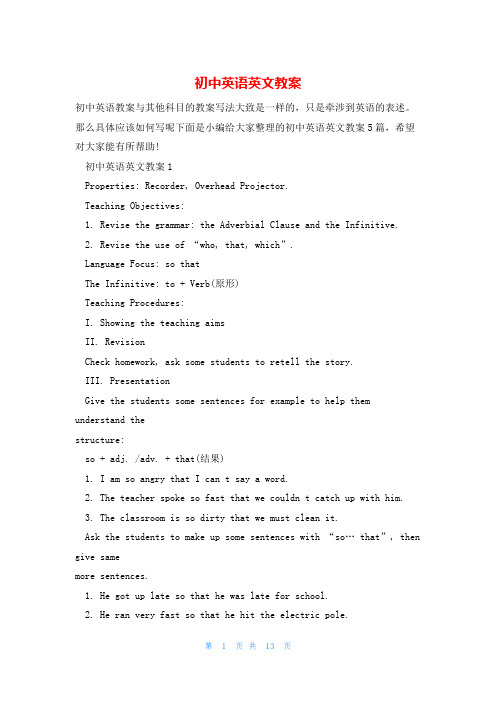
初中英语英文教案初中英语教案与其他科目的教案写法大致是一样的,只是牵涉到英语的表述。
那么具体应该如何写呢下面是小编给大家整理的初中英语英文教案5篇,希望对大家能有所帮助!初中英语英文教案1Properties: Recorder, Overhead Projector.Teaching Objectives:1. Revise the grammar: the Adverbial Clause and the Infinitive.2. Revise the use of “who, that, which”.Language Focus: so thatThe Infinitive: to + Verb(原形)Teaching Procedures:I. Showing the teaching aimsII. RevisionCheck homework, ask some students to retell the story.III. PresentationGive the students some sentences for example to help them understand thestructure:so + adj. /adv. + that(结果)1. I am so angry that I can t say a word.2. The teacher spoke so fast that we couldn t catch up with him.3. The classroom is so dirty that we must clean it.Ask the students to make up some sentences with “so… that”, then give samemore sentences.1. He got up late so that he was late for school.2. He ran very fast so that he hit the electric pole.Ask the students to do some practice.IV. PracticeLook at Exercise 1, ask the students to answer the questions withso that….The answers are:1. I stayed at home so that I could go swimming when I had finished it.2. Lucy saved her money so that she could buy her mother a birthday present.3. Ling Feng was going to Changsha the next week so that he couldvisit hissick grandmother.4. I was doing my homework so that I could ask him to help me withmyphysics.5. I was looking for Lin Tao so that he could visit sick grandmother.V. PresentationGet the students to make up some sentences like:1. I don t know how to get to the station.2. She doesn t know which sweater to choose.Ask the students to pay attrition to the Infinitive. Give them more examples to understand better, e. g.1. I don t know what to do next.2. They don t know where to go.3. We didn t know when to start.Focus on the use of the Infinitive, then give another example:It’s very important to lea rn English well:To learn English well is very important.Let the students make more sentences, pay attention to the use of theInfinitive.VI. PracticeLook at Exercise 2, make sentences with partners. The answers are:1. It’s hard / easy to work out these maths problem.2. It’s exciting to watch football matches.3. It’s interesting to read history books.4. It’s hard / easy to learn foreign languages.VII. Leaning and practiceDo Exercise 3, complete the sentences using who/ that/ which. The answersare:1.which2.who3.who4.which5.who6.which7.which8.whoVIII. WorkbookDo Exercise 1, let the students translate the sentences alone then checkthe answers with the students.Answers: 1. We arc hungry. We need to buy something to eat. 2. She is verybusy today. She has a lot of work to do. 3. Please be quiet! I have somethingimportant to tell you. 4. Will you please tell him to turn down the TV a little5. nobody knows what to do next6. I’m going to the post office to buy a fewstamps this afternoon.For Exercise 2. Join the two parts and make the students read together.For Exercise 3. Get the students to read the story, and fill in the blanks.The answers are: which, who, who, who, whoIX. SummaryExercise in classl. 昨天他想借我的收音机.2. 我需要一些喝的东西。
初中英语规范教案

初中英语规范教案教学目标:1. 能够听说读写关于天气的词汇,如sunny, cloudy, rainy, windy等。
2. 能够用现在进行时描述天气情况。
3. 能够用It's ... outside.来描述外面的天气。
4. 能够用What's the weather like...?来询问天气情况。
5. 能够用Yes, it is. / No, it isn't.来回答天气的疑问句。
教学内容:1. 单词:sunny, cloudy, rainy, windy, snowy, hot, cold, warm, cool。
2. 短语:What's the weather like outside? It's raining!/ It's sunny./ It's cloudy./ It's windy./ It's snowy.3. 句子:I can see ... outside. The weather is ... outside.教学步骤:1. 导入:教师通过展示不同的天气图片,引导学生说出相应的天气词汇。
2. 新课内容展示:教师通过PPT展示天气词汇和短语,讲解它们的用法和意思。
3. 听力练习:教师播放对话或短文,学生听后回答相关问题,巩固对天气词汇和短语的理解。
4. 口语练习:学生分角色扮演,用天气词汇和短语进行对话,培养口语表达能力。
5. 书写练习:学生根据给定的情景,用天气词汇和短语写一段话,描述外面的天气。
6. 课堂小结:教师总结本节课所学内容,强调重点和难点。
7. 作业布置:学生回家后,用天气词汇和短语给家人或朋友发一条天气预报。
教学评价:1. 课堂参与度:观察学生在课堂上的积极参与情况,如发言、互动等。
2. 听力理解能力:通过听力练习,评估学生对天气词汇和短语的理解程度。
3. 口语表达能力:通过口语练习,评估学生运用天气词汇和短语进行对话的能力。
初中英语教案模板【精选6篇】
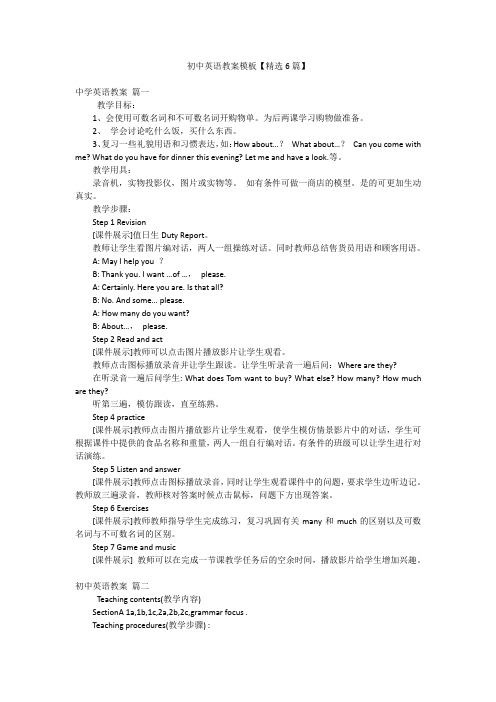
初中英语教案模板【精选6篇】中学英语教案篇一教学目标:1、会使用可数名词和不可数名词开购物单。
为后两课学习购物做准备。
2、学会讨论吃什么饭,买什么东西。
3、复习一些礼貌用语和习惯表达,如:How about…?What about…?Can you come with me? What do you have for dinner this evening? Let me and have a look.等。
教学用具:录音机,实物投影仪,图片或实物等。
如有条件可做一商店的模型。
是的可更加生动真实。
教学步骤:Step 1 Revision[课件展示]值日生Duty Report。
教师让学生看图片编对话,两人一组操练对话。
同时教师总结售货员用语和顾客用语。
A: May I help you ?B: Thank you. I want …of …,please.A: Certainly. Here you are. Is that all?B: No. And some… please.A: How many do you want?B: About…,please.Step 2 Read and act[课件展示]教师可以点击图片播放影片让学生观看。
教师点击图标播放录音并让学生跟读。
让学生听录音一遍后问:Where are they?在听录音一遍后问学生: What does Tom want to buy? What else? How many? How much are they?听第三遍,模仿跟读,直至练熟。
Step 4 practice[课件展示]教师点击图片播放影片让学生观看,使学生模仿情景影片中的对话,学生可根据课件中提供的食品名称和重量,两人一组自行编对话。
有条件的班级可以让学生进行对话演练。
Step 5 Listen and answer[课件展示]教师点击图标播放录音,同时让学生观看课件中的问题,要求学生边听边记。
初中英语教案万能模板
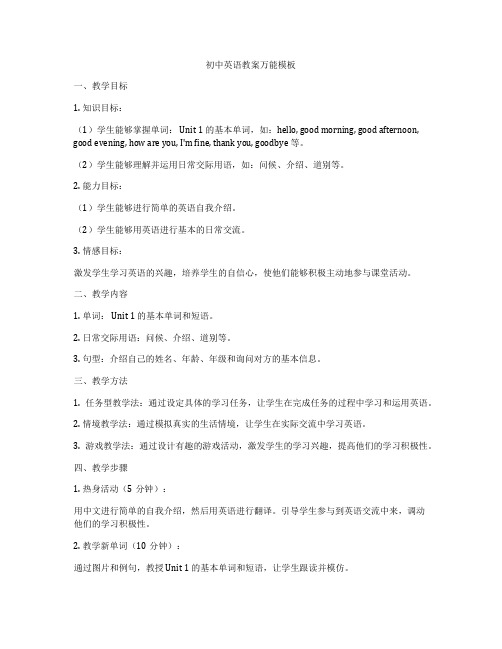
初中英语教案万能模板一、教学目标1. 知识目标:(1)学生能够掌握单词: Unit 1 的基本单词,如:hello, good morning, good afternoon, good evening, how are you, I'm fine, thank you, goodbye 等。
(2)学生能够理解并运用日常交际用语,如:问候、介绍、道别等。
2. 能力目标:(1)学生能够进行简单的英语自我介绍。
(2)学生能够用英语进行基本的日常交流。
3. 情感目标:激发学生学习英语的兴趣,培养学生的自信心,使他们能够积极主动地参与课堂活动。
二、教学内容1. 单词: Unit 1 的基本单词和短语。
2. 日常交际用语:问候、介绍、道别等。
3. 句型:介绍自己的姓名、年龄、年级和询问对方的基本信息。
三、教学方法1. 任务型教学法:通过设定具体的学习任务,让学生在完成任务的过程中学习和运用英语。
2. 情境教学法:通过模拟真实的生活情境,让学生在实际交流中学习英语。
3. 游戏教学法:通过设计有趣的游戏活动,激发学生的学习兴趣,提高他们的学习积极性。
四、教学步骤1. 热身活动(5分钟):用中文进行简单的自我介绍,然后用英语进行翻译。
引导学生参与到英语交流中来,调动他们的学习积极性。
2. 教学新单词(10分钟):通过图片和例句,教授 Unit 1 的基本单词和短语,让学生跟读并模仿。
3. 讲解日常交际用语(10分钟):讲解并示范问候、介绍、道别等日常交际用语,让学生进行实际操作练习。
4. 句型练习(10分钟):通过角色扮演和小组活动,让学生练习介绍自己的姓名、年龄、年级和询问对方的基本信息。
5. 游戏活动(10分钟):设计一个简单的英语游戏,如“单词接龙”,让学生在游戏中进一步巩固所学知识。
6. 总结与作业布置(5分钟):对本节课所学内容进行总结,布置作业,要求学生复习所学单词和短语,并尝试用英语进行自我介绍。
初中英语教学设计【优秀14篇】
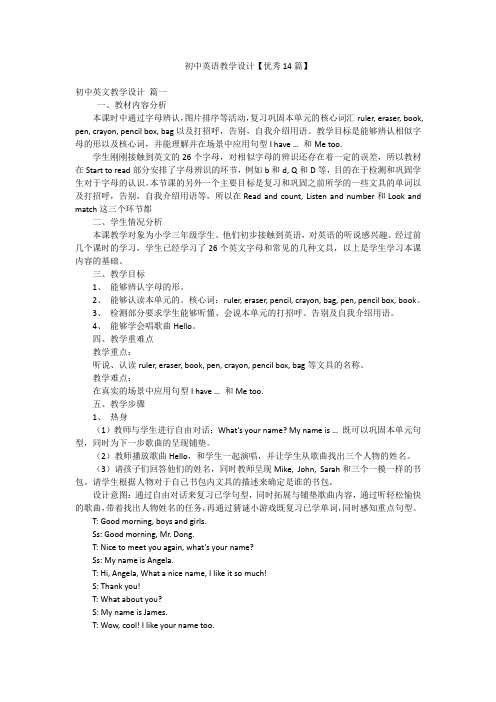
初中英语教学设计【优秀14篇】初中英文教学设计篇一一、教材内容分析本课时中通过字母辨认,图片排序等活动,复习巩固本单元的核心词汇ruler, eraser, book, pen, crayon, pencil box, bag以及打招呼,告别,自我介绍用语。
教学目标是能够辨认相似字母的形以及核心词,并能理解并在场景中应用句型I have … 和Me too.学生刚刚接触到英文的26个字母,对相似字母的辨识还存在着一定的误差,所以教材在Start to read部分安排了字母辨识的环节,例如b和d, Q和D等,目的在于检测和巩固学生对于字母的认识。
本节课的另外一个主要目标是复习和巩固之前所学的一些文具的单词以及打招呼,告别,自我介绍用语等,所以在Read and count, Listen and number和Look and match这三个环节都二、学生情况分析本课教学对象为小学三年级学生。
他们初步接触到英语,对英语的听说感兴趣。
经过前几个课时的学习,学生已经学习了26个英文字母和常见的几种文具,以上是学生学习本课内容的基础。
三、教学目标1、能够辨认字母的形。
2、能够认读本单元的。
核心词:ruler, eraser, pencil, crayon, bag, pen, pencil box, book。
3、检测部分要求学生能够听懂、会说本单元的打招呼、告别及自我介绍用语。
4、能够学会唱歌曲Hello。
四、教学重难点教学重点:听说、认读ruler, eraser, book, pen, crayon, pencil box, bag等文具的名称。
教学难点:在真实的场景中应用句型I have … 和Me too.五、教学步骤1、热身(1)教师与学生进行自由对话:What’s your name? My name is … 既可以巩固本单元句型,同时为下一步歌曲的呈现铺垫。
(2)教师播放歌曲Hello,和学生一起演唱,并让学生从歌曲找出三个人物的姓名。
初中英语公开课教案模板格式

---课程名称: [课程名称,如:英语语法入门]授课年级: [年级,如:七年级]授课班级: [班级,如:七年级(1)班]授课时间: [具体时间,如:2023年10月25日星期三第2节课]教学目标:1. 知识目标:- 学生能够理解并掌握一般现在时的基本用法。
- 学生能够识别并运用一般现在时的句型结构。
2. 能力目标:- 学生能够运用一般现在时进行简单的日常对话。
- 学生能够通过实际情景运用所学语法知识。
3. 情感目标:- 激发学生学习英语的兴趣,培养良好的学习习惯。
- 增强学生的自信心,鼓励他们在公开场合进行英语表达。
教学重点:1. 一般现在时的构成。
2. 一般现在时的句型结构。
教学难点:1. 一般现在时与现在进行时的区分。
2. 一般现在时在具体语境中的运用。
教学方法:- 情境教学法- 任务型教学法- 合作学习法教学准备:- 多媒体课件- 实物教具(如:图片、卡片等)- 课堂活动材料---教学过程一、导入(5分钟)1. 热身活动:- 用简单的英语问候学生,检查学生的英语口语水平。
- 提问:“What do you usually do in your free time?” 引导学生用一般现在时回答。
2. 引入课题:- 展示一张日常活动的图片,如:学生上课、做作业等。
- 提问:“What are they doing?” 引导学生思考一般现在时的用法。
二、新课讲授(20分钟)1. 语法讲解:- 讲解一般现在时的构成:主语 + 动词原形。
- 举例说明一般现在时的句型结构,如:I am a student. She likes reading books.2. 练习巩固:- 学生跟读并模仿课件中的例句。
- 进行语法填空练习,巩固一般现在时的用法。
3. 实际运用:- 分组活动,让学生用一般现在时描述自己的日常生活。
- 教师巡视指导,纠正学生的语法错误。
三、课堂活动(15分钟)1. 角色扮演:- 分组进行角色扮演,模拟日常对话场景,如:询问天气、询问兴趣爱好等。
- 1、下载文档前请自行甄别文档内容的完整性,平台不提供额外的编辑、内容补充、找答案等附加服务。
- 2、"仅部分预览"的文档,不可在线预览部分如存在完整性等问题,可反馈申请退款(可完整预览的文档不适用该条件!)。
- 3、如文档侵犯您的权益,请联系客服反馈,我们会尽快为您处理(人工客服工作时间:9:00-18:30)。
云南省教师资格认定考试教育教学能力测试教学方案姓名:张俊利资格种类:初中教师资格任教科目:英语《What’s the highest mountain in the world?》Teaching Plan[The basic information]1.Subject:English2.Topic:What’s the highest mountain in the world?3.Class:Grade 84.The teacher:Zhang Junli5. Type of lesson:New lesson6. Theaching hour:One class hour7.Teaching aid:Multi-media[Teaching Objectives]1. Knowledge objectiveNew words : Qomolangma,the Nile, the Caspian Sea, the Sahara ,square,kilometer ,desert ,populationPhrases: in size,in the word, meters deep/long/high,as...as, the biggest population. Sentence: What’s the highest mountain in the world?How long is Qomolangma?It’s 8,844.43 meters high. It’s higher than any other mountain.Which is the deepest salt lake in the world?The Caspian Sea is the deepest of all the salt lake.Did you know that China is one of the oldest countries in the world?Yes, I did. It’s much older than the US.2. Ability objectiveLet the students can understand and talk about the topic of geography and natural. Master the usage of the comparative and superlative.3. Emotion objectiveTo cultivate the students love the nature, make them have the consciousness of protecting the environment.[Teaching main and difficult points]1. Teaching main pointsUse comparative and superlative forms of adjective and adverbs2. Teaching difficult pointsTalk about the geography and nature using comparative and superlative forms of adjective and adverbs.The contrast between the object.[Teaching Methods]1.Task-based Methodmunicative Approach3.Situational Approach[Teaching Procedures]Step1.Leading-in1. Watch the photos and talk about them “How big/high/long/big is …?’ and help thestudents to answer: It’s …meters/kilometers/cm big/high/long/big.2. Look these photos and practice the dialogue:e.g. A: How high is Qomolangma?B: It’s 8,844 meters high.Step 2. Match the facts you know.Practice in pairs using the information in 1a.Step 3 Explaination…8,844 meters high. 8,844米高… meters high (long, wide…)……米高(长,宽……)。
英语表示“有多长(宽,高……)”时,一般将数词和数量单位放在表示长宽高的形容词前作状语。
e.g. The wall is 1.7 metres wide.Step 4 Listening 新课标第一网1. 1b Listen and complete the sentences.1) Qomolangma is ______ than any other mountain in the world.2) The Sahara is ____________ desert in the world.3) The Caspian Sea is ____________ of all the salt lakes.4) The Nile is _________ river in the world.2. 2a Listen and number the facts(1- 4) in the order you hear them.6,300 5,000 5,464 300The Yangtze River is about ____ kilometers long and the Yellow River is ___ kilometers long.China has the bi ggest population in the world. It’s a lot bigger than the population of the US.China is over ___ years old. It has a much longer history than the US. The US is not even ___ years old.China is almost as big as the US, but it is the biggest country in Asia.Step 5 The usage of the comparative and superlative1.一般单音节词和少数以-er,-ow结尾的双音节词,比较级在后面加-er,最高级在后面加-est;(1)单音节词e.g. small→smaller→smallest short→shorter→shortesttall→taller→tallest great→greater→greatest(2)双音节词e.g. clever→cleverer→cleverest narrow→narrower→narrowest2.以不发音e结尾的单音节词,比较在原级后加-r,最高级在原级后加-st;e.g. large→larger→largest nice→nicer→nicest able→abler→ablest3.在重读闭音节(即:辅音+元音+辅音)中,先双写末尾的辅音字母,比较级加-er,最高级加-est;e.g. big→bigger→biggest hot→hotter→hottest fat→fatter→fattest4.以“辅音字母+y”结尾的双音节词,把y改为i,比较级加-er,最高级加-est;e.g. easy→easier→easiest heavy→heavier→heaviestbusy→busier→busiest happy→happier→happiest5.其他双音节词和多音节词,比较级在前面加more,最高级在前面加most;e.g. beautiful→more beautiful→most beautifulStep 6 Practice1c Make conversations in pairs.ExamplesA: Did you know that China if one of the oldest countries in the world?B: Yes, I did. I t’s much older than my country.Step 7 SummaryGo through the important points and difficult points of this lesson with the students once again.Emphasis the phrases and sentence patterns.Retell the the usage of the comparative and superlative.Step 8 Homework w W w .x K b 1.c o M1.To memorize the important phrases and sentences.2.To make some dialogues about asking the size of objects.3. find some information about Qomolangma On the InternetAdd :[The Blackboard Design]What’s the highest mountain in the world?1.New words : Qomolangma,the Nile, the Caspian Sea, the Sahara ,square, kilometer ,desert ,population2.Phrases: in size,in the word, meters deep/long/high,as...as, the biggest population.3.Sentence: What’s the highest mountain in the world?How long is Qomolangma?t’s 8,844.43 meters high. It’s higher than any other mountain.Did you know that China is one of the oldest countries in the world?4.The usage of the comparative and superlative1.一般单音节词和少数以-er,-ow结尾的双音节词,比较级在后面加-er,最高级在后面加-est;(1)单音节词e.g. small→smaller→smallest short→shorter→shortesttall→taller→tallest great→greater→greatest(2)双音节词e.g. clever→cleverer→cleverest narrow→narrower→narrowest2.以不发音e结尾的单音节词,比较在原级后加-r,最高级在原级后加-st;e.g. large→larger→largest nice→nicer→nicest able→abler→ablest3.在重读闭音节(即:辅音+元音+辅音)中,先双写末尾的辅音字母,比较级加-er,最高级加-est;e.g. big→bigger→biggest hot→hotter→hottest fat→fatter→fattest4.以“辅音字母+y”结尾的双音节词,把y改为i,比较级加-er,最高级加-est;e.g. easy→easier→easiest heavy→heavier→heaviestbusy→busier→busiest happy→happier→happiest5.其他双音节词和多音节词,比较级在前面加more,最高级在前面加most;e.g. beautiful→more beautiful→most beautifu l(注:文档可能无法思考全面,请浏览后下载,供参考。
